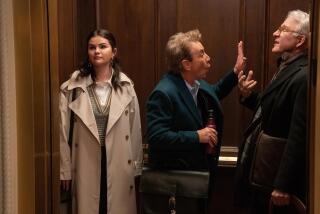Cable TV Gains More Viewers as It Tries to Shed Rerun Image
- Share via
A 14th presidential candidate, Jack Quentin Tanner, will be pressing the flesh and mugging for the news cameras along the New Hampshire campaign trail over the next several weeks, right alongside George Bush, Robert Dole, Gary Hart, Jesse Jackson and all the rest of the men running for the nation’s highest office. He’ll smile through snow flurries, speak in 25-second sound bites and continually toot the buzz words of his own political platform.
But this well-dressed presidential contender has no pretensions of actually getting to the White House or even of qualifying for federal matching funds. He is an actor in a new HBO television series created by Robert Altman and Garry Trudeau that blurs the line between television and real life.
Though he won’t collect any actual votes when New Hampshire residents go to the polls in February, this fanciful candidate, along with the stars of other such innovative programming, represent the hopes of the cable industry in 1988 as it campaigns to push itself into more than 70% of the nation’s television households.
Buoyed by the debut of National Football League games on ESPN and the public’s hunger for immediate access to information during a tumultuous news year that featured live coverage of the Iran-Contra hearings and minute-by-minute reports of the stock market crash on cable channels such as Cable News Network, C-SPAN and Financial News Network, cable penetration exceeded 50% of American homes in 1987.
According to the most recent A.C. Nielsen statistics, more than 44 million households now receive their television via cable, up 10% from the previous year. While the audience for the three broadcast networks declined in 1987, the National Cable Television Assn. reported that prime-time viewership of basic cable channels was up 23% over 1986. The audience for pay channels in 1987 rose approximately 6%.
“Cable is reaching critical mass both as a force in television programming and in the consumer’s perception of what constitutes a full menu of television choices,” said Jim Mooney, president of the NCTA. “Today, watching only broadcast television is like eating at McDonald’s every night. Viewers are now aware of the possibilities.”
This surge in the need for more television choices occurred in spite of a 7% increase in the cost of cable to the average subscriber in 1987, the first year of deregulation of subscriber rates under a 1984 law that regulates the cable industry. And, more important to industry insiders, cable viewership soared in 1987 despite the prevailing public perception that cable is still the great purveyor of broadcast television reruns.
Many within the industry, including Tom Freston, president of MTV Networks, have said that cable must shed that image by aggressively creating original programming in order to earn more respect and substantially increase its subscriber base.
Freston has pointed to such cable successes as “Double Dare,” Nickelodeon’s game show for children, and its sale in syndication to broadcast stations as an example of such programming leadership. Showtime’s recent sale of reruns of “It’s Garry Shandling’s Show” to Fox also suggests to some that cable programming “has come of age.”
Some cable operators argue that allowing original cable programming such as “Double Dare” to become available on broadcast television might be counterproductive to cable’s drive to lure new subscribers. Others worry that the inevitability of popular cable stars such as Shandling signing broadcast or movie deals will deplete cable of its stars and originality.
But cable programming advocates rebuke such criticism by saying that it is better to sell cable’s reruns to broadcast television than to continually rely on broadcast TV’s relics. And many contend that such high-stakes attention to cable programming can only be beneficial to the industry as a whole.
But even with the industry’s increased commitment to original programming, cable subscribers will still be able to watch their fill of “Mr. Ed,” “My Three Sons” and “The Beverly Hillbillies” along with their 24 hours a day of music videos, news and sports. And two of cable’s most noteworthy coups in recent months were the purchase of the rights to air reruns of “Miami Vice” by the USA Network and “Cagney & Lacey” by Lifetime.
While endorsing the growth of original programming as a way to distinguish cable from broadcast television and win new subscribers, the NCTA’s Mooney said that acquiring the rights to high-profile broadcast shows such as “Miami Vice” would also help boost the size of the cable audience.
“Cable gets its audience in little bites, and all those small bites add up to one giant dent (in the broadcast television audience),” Mooney said. “I think it’s an oversimplification to say that all or most programming should be original. Cable is a multichannel medium, and there’s a whole lot of room for all kinds of programming.”
Mooney said that with more than half the nation’s homes now wired, cable programming has already become an integral part of daily conversations around the office water cooler. But further growth in cable’s penetration is critical, he believes, because with additional subscriber revenue, individual cable channels will be able to sink more money into original programming, which, in theory, will attract additional subscribers.
“Original programming is tremendously important to us,” said Bridget Potter, senior vice president of programming at HBO. “Since the advent of the VCR, where every theatrical film is available long before it ever gets to pay television, original programming is now the only exclusive programming we have. It used to be considered a retention device--something to keep people watching once they’d subscribed. Now we think it’s a much stronger asset than that. We are finding a real appetite out there for original programs on pay television.”
Many industry insiders believe that the pay channels as well as the large basic networks such as ESPN, CNN and MTV have carried cable to its current level of success. Now, they contend, it is up to the smaller specialty channels, with their own narrowly targeted programs, to lead the charge toward increased cable penetration.
But basic channels often need help funding original programming on a wide scale. While executives such as Freston champion creative leadership within the cable industry, most basic channels can afford only a limited creative budget and still must fill scores of hours of air time each week. Nickelodeon, for example, screens hours of old television reruns each day.
In 1987, some of these basic channels found a friendly patron in the cable operators themselves, who began to invest money in channels such as Black Entertainment Television and the Discovery Channel to help finance new programming. Such business arrangements should continue to be the norm in 1988.
More to Read
The biggest entertainment stories
Get our big stories about Hollywood, film, television, music, arts, culture and more right in your inbox as soon as they publish.
You may occasionally receive promotional content from the Los Angeles Times.










